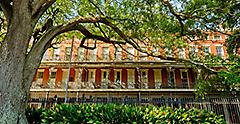The History Of New Orleans Voodoo And The City's Voodoo Queen
Published on September 22, 2023
Voodoo Magic in the Big Easy
How one powerful voodoo priestess shaped New Orleans.
Much like the city itself, New Orleans Voodoo stems from blended beliefs and cultures. Learn about how Marie Laveau, a Voodoo priestess, used her connections and charisma to influence the city in ways few others have.
1. What Exactly Is Voodoo And Where Did It Start?
An utterance of the word "Voodoo" can create images of zombies and dolls with pins stuck in them. However, Voodoo is largely misunderstood and more complex than these pop culture stereotypes make it seem.
Voodoo is an ancient religion with roots in West Africa, where it has millions of followers in the modern-day countries of Benin, Togo, Nigeria and Ghana. The word Voodoo means spirit, and it is believed that spirits preside over all aspects of life. West African Voodoo honors one supreme god as well as hundreds of other deities devoted to love, healing, agriculture, water, weather, fertility and all things relating to the human condition. Voodoo priests link the spiritual realm with the human world through rituals, often asking favors from the Voodoo spirits. It is often believed that the human realm is shaped more by spirits rather than the will of one god.
2. Voodoo As A Form Of Rebellion
3. A Kinship Formed Through Worship
4. A Surprising Hybrid Of Religions
While it's easy to confuse the different types of Voodoo across the world, each has its own set of distinct rituals and beliefs. As New Orleans Voodoo evolved to incorporate aspects of the local culture to hide from those who wanted to quell the religion, it developed distinctive elements that made it different from West African and Haitian Voodoo. Roman Catholic saints were often viewed as aliases of their Voodoo deities (called loa or Iwa), allowing people to celebrate Voodoo and Roman Catholic holidays alongside one another. And while the religions might seem counterintuitive to one another, many believers of Voodoo simultaneously believe in Christianity today as a nuanced form of Voodoo-Catholicism.
Much of Voodoo history has been lost as the religion was passed down orally and largely forced to take place in the quiet corners of society. Like all religions, there are many branches of Voodoo with interpretations and rituals that vary from one believer to the next.
5. The Power Of Magic Talismans
6. Zombie Lore
7. The Significance Of Voodoo Dolls
8. New Orleans Voodoo
9. Voodoo Queen Marie Laveau
While many various priests and priestesses led the Voodoo community for decades, there is none more influential than Marie Laveau. Sometime between 1794-1801 (historians are uncertain), Marie Laveau's was born to Marguerite Darcantrel, a Haitian, and Charles Laveau, a wealthy Creole politician. It is said that Marie Laveau's grandmother was a beloved Voodoo priestess in Haiti, whose beliefs passed through Marie Laveau's mother onward to her.
Marie Laveau married the first free man of color, Jacques Paris. When he died, Marie married and had 15 children with Christophe de Glapion, also a free man of color. She studied Voodoo under the wing of one of the great Voodoo priests of the time, Bayou John. Bayou John was a Senegalese Voodoo king who was captured and brought as a slave to Cuba. He then worked as a cotton roller in New Orleans, where he quickly gained popularity thanks to his Voodoo teachings. Marie Laveau also learned from Sanite Dede, the first celebrity priestess of Voodoo in the city, and Marie Saloppe, a woman people sought when they thought they'd been hexed.
In between learning the ropes of becoming a Voodoo priestess, Marie Laveau earned a modest income as a hairdresser for wealthy women of New Orleans society. Using Marie Laveau as an armchair therapist, many of these women told Marie Laveau of their personal problems. The women would also gossip among themselves. Embedded in the African community, Marie Laveau became privy to information from house servants on plantations. Marie Laveau was able to learn details of the inside world of the city's social elite and it is speculated that she used this knowledge to her advantage as a Voodoo priestess.
10. Spells And Socializing
11. A Devout Catholic And Voodoo Practitioner
Aside from Congo Square, private ceremonies and readings were hosted in Marie Laveau's backyard. Larger gatherings took place at Bayou St. John near Lake Pontchartrain. Singing, drumming, dancing and worshipping were all part of the ceremonies. In 1830, Marie Laveau started celebrating the summer solstice holiday of St. John's Eve at Bayou St. John, an event that still takes place today. People from all walks of life including politicians, police officers and social elites would come to witness the goings-on.
Marie Laveau passed away in 1881 and is laid to rest at St. Louis Cemetery No. 1. Legend states that if you who visit her tomb, leave three offerings and make a wish, Marie Laveau will grant it. Voodoo pilgrims and tourists alike commonly pay homage to the Voodoo Queen at her final resting place.
12. Experience New Orleans Voodoo Firsthand
Though there are not as many followers of Voodoo today as there once were, a walk around New Orleans will reveal that its mysticism and allure has yet to retreat into the pages of a dusty history book. Voodoo altars are often tucked away in homes, hidden from prying eyes. Despite the religion's elusiveness, there are plenty of ways to learn about Voodoo firsthand.
Note: Many of these sites are walking distance from one another and can be seen as stops on a guided or D.I.Y. walking tour.
13. New Orleans Historic Voodoo Museum
14. The Voodoo Spirtual Temple
15. House Of Voodoo
And if it's souvenirs you're after, look no further than the shops of Voodoo Authentica, Marie Laveau's House of Voodoo or Reverend Zombie's House of Voodoo. Each sells some variation of potions, dolls, charms, gris-gris, incense, tarot cards and blessings in between post cards and wares in their rustic shops.
Embark on an unforgettable adventure as you set sail from the vibrant city of New Orleans on your next cruise.



















